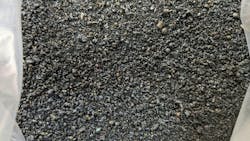Reviving Battery Processing Waste: Innovations in Recycling
In January, we took a look at black mass and the valuable materials it contains, such as lithium, cobalt, manganese and nickel. Black mass is the material left over at the end of the lithium-ion battery production process.
When dealing with resource-rich waste streams like black mass, battery processing operators must ACT like a recycler but THINK like a chemical plant. While this sounds simple, recyclers are generally concerned with the battery transport and collection, storage and mechanical treatment of the battery itself. However, to recover the battery-grade materials, the operation is a chemical plant handling solvents, gases, temperature and pressure systems, solids conveying and containment, automation and similar unit operations.
The mechanical/drying/sorting process of lithium-ion batteries (LIBs) produces black mass, which is then conveyed or transferred to one of the three main recycling methods: pyrometallurgical, hydrometallurgical or direct recycling processes.
First, a brief overview. The pyrometallurgical (pyro) process is a high-temperature smelting or roasting process, which usually involves burning and subsequent separation. Hydrometallurgical (hydromet) process is achieved using aqueous chemistry via leaching in acids (or bases) and subsequent concentration and purification. Direct recycling directly harvests and recovers active materials of LIBs, while retaining their original compound structure.
As you can imagine, the hydromet and direct processes are leading the chemical innovation highway for LIBs recycling, and these are the most fun. In fact, many pyro processes produce only intermediate chemicals and must use a type of hydromet or direct process to fully recover or further refine the materials from the black mass to produce “battery-grade” materials.
So, let’s quickly review the different types of pyro processes, so you can get a full view of the landscape. In subsequent columns we will review, in more detail, the hydromet and direct recycling processes. These are leading the way, and if you’re looking for a career change, I suggest reading onwards.
Pyrometallurgical processes are well established from the mining industry and are used for primary and secondary ore materials, including copper, gold and others. Types of pyrometallurgical processes include roasting, which consists of a gas–solid reaction (oxidizing) to purify the ore or a secondary raw material. Smelting, typically operating at around 1,500°C, is more of an extraction process where the metal is extracted from an ore or secondary raw material. Smelting uses heat and a chemical reducing agent to decompose the ore/secondary raw material, driving off the other elements as gases or slag and leaving the metal base behind.
It is a capital-intensive process as toxic fluorine compounds and organic compounds, which form and release during smelting, require treating. It also requires large filter presses and mixers for slag handling and fly ash treating after smelting.
In the LIBs recycling value chain, the pyro process has benefits in that it can handle all types of batteries, such as EV batteries, small-format batteries and power tools. This is enabled by the initial heat-treatment step, where high-temperature smelting oxidizes organic materials like plastics, separators, electrolytes and aluminum.
In the LIBs recycling value chain, the pyro process can handle all battery types, such as EV batteries, small-format batteries and those used in power tools. This is enabled by the initial heat-treatment step, which oxidizes organic materials like plastics, separators, electrolytes and aluminum through high-temperature smelting.
The black mass is recovered as a mixture of nickel and cobalt alloys as well as cobalt, manganese and nickel stable oxides. Lithium, in the form of oxides and carbonates, as well as aluminum, are in the slag residue.
Finally, as with all pyro processes, the high temperatures require energy-intensive operations, which can result in greenhouse-gas emissions and other byproducts to generate the heat. So, while the pyro process has many benefits, it still requires innovative thinking to minimize energy use. Some methods to consider include steam generation using waste heat, burning carbon materials in the batteries to generate and the use of solar and wind energy with energy storage systems.
In contrast, the hydromet processes and direct recycling use chemical reactions, precipitations and other unit operations rather than high-temperature processes to recover the battery-grade materials. These processes involve the nitty-gritty of typical chemical process engineering and face many challenges. We will explore these issues in more detail in future columns, so stay tuned.
About the Author
Barry Perlmutter
President of Perlmutter & Idea Development (P&ID) LLC
Barry Perlmutter is president of Perlmutter & Idea Development (P&ID) LLC. He has over 40 years of science, engineering and business marketing experience in the field of solid-liquid separation including filtration, centrifugation, process drying, mixing and recycling. His strong professional skills focus on process and project solutions, innovation strategies and execution, market expansion and business development. Barry has published and presented worldwide on applications in the chemical, pharmaceutical, and energy/environmental industries and has been responsible for introducing many European technologies into the Americas marketplace. His two books, published by Elsevier, Amsterdam, "Handbook of Solid-Liquid Filtration" and "Integration & Optimization of Unit Operations" are used worldwide for process guidance.


